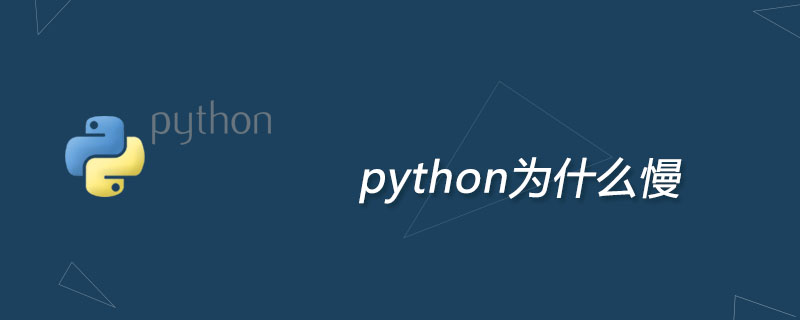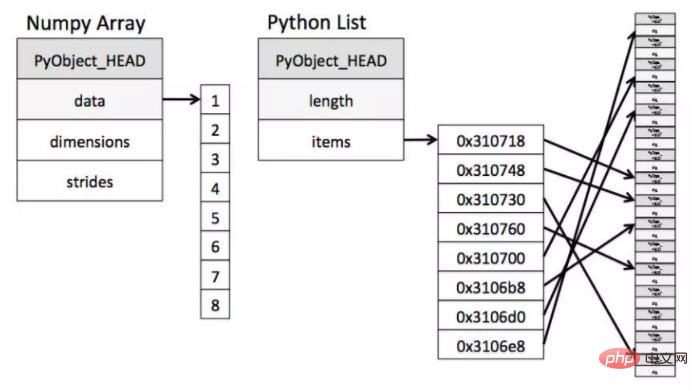Why is python slow?
Python is a dynamically typed, interpreted language. For many developers, it is well known that Python runs slowly. Its characteristic that everything is an object is one of the reasons for its slow running. The following article explains Let me introduce to you some reasons why python is slow. I hope it will be helpful to you.

Python is a dynamic language, not a static language
This means that when the python program is executed, it is compiled The compiler does not know the type of the variable. In C, the compiler knows the type of a variable when it is defined, but in python it only knows that it is an object when executed.
So if you write the following in C:
/ * C代码* / int a = 1 ; int b = 2 ; int c = a + b ;
The C compiler knows from the start that a and b are integers: they simply cannot be anything else! With this knowledge, it can call a routine that adds two integers, returning another integer that is just a simple value in memory.
The process executed in C is roughly as follows:
1. Assign
2. Assign
3. Call binary addition binary_add(a, b)
4. Assign the structure to a c variable
python medium The effective code is as follows:
# python code a = 1 b = 2 c = a + b
Here the interpreter only knows that 1 and 2 are objects, but does not know what type of objects they are. So the interpreter must check each variable's PyObject_HEAD to find the type information, and then call the appropriate summation routine for both types. Finally, it must create and initialize a new Python object to hold the return value.
The execution process is roughly as follows:
1. Assign 1 to a
(1) Set a->PyObject_HEAD->typecode to an integer
(2) Set Seta->val = 1
2, assign 2 to b
(1) Set b->PyObject_HEAD->typecode to an integer
(2) Set b->val = 2
3. Call binary addition binary_add(a, b)
(1) Find the type code a->PyObject_HEAD
(2) a is an integer, the value is a->val
(3) Find the type code b->PyObject_HEAD
(4) b is an integer, the value is b ->val
(5) Call binary addition binary_add(a->val, b->val)
(6) The result is result, which is an integer.
4. Create a new object c
(1) Set c->PyObject_HEAD->typecode to an integer
(2) Assign c->val Giving the result
dynamic typing means any operation requires more steps. This is the main reason why Python is slower than C when it comes to numerical data operations.
Python is an interpreted language rather than a compiled language
The differences between interpreted languages and compiled languages will also cause differences in the speed of program execution. . An intelligent compiler can predict and optimize for repetitive and unnecessary operations. This will also increase the speed of program execution.
Python’s object model will bring inefficient memory access
In the above example, compared to the C language, operating on integers in Python will cause An additional layer of type information. When there are a lot of integers and you want to perform some kind of batch operation, a list is often used in python, and a buffer-based array is used in C. In its simplest form, a Numpy array is a Python object built around an array in C. That is to say, Numpy has a pointer pointing to the value of the continuous cache area data, while in python, the python list has a pointer that only wants to cache the area. Each pointer points to a python cache object, and each object is bound to a data (an integer in this case).
Schematic diagrams of these two situations:

It can be clearly seen from the above figure that when operating on data (such as sorting, calculation , search, etc.), Numpy is more efficient than python in terms of survival cost and access cost.
The above is the detailed content of Why is python slow?. For more information, please follow other related articles on the PHP Chinese website!

Hot AI Tools

Undresser.AI Undress
AI-powered app for creating realistic nude photos

AI Clothes Remover
Online AI tool for removing clothes from photos.

Undress AI Tool
Undress images for free

Clothoff.io
AI clothes remover

Video Face Swap
Swap faces in any video effortlessly with our completely free AI face swap tool!

Hot Article

Hot Tools

Notepad++7.3.1
Easy-to-use and free code editor

SublimeText3 Chinese version
Chinese version, very easy to use

Zend Studio 13.0.1
Powerful PHP integrated development environment

Dreamweaver CS6
Visual web development tools

SublimeText3 Mac version
God-level code editing software (SublimeText3)

Hot Topics
 PHP and Python: Different Paradigms Explained
Apr 18, 2025 am 12:26 AM
PHP and Python: Different Paradigms Explained
Apr 18, 2025 am 12:26 AM
PHP is mainly procedural programming, but also supports object-oriented programming (OOP); Python supports a variety of paradigms, including OOP, functional and procedural programming. PHP is suitable for web development, and Python is suitable for a variety of applications such as data analysis and machine learning.
 Choosing Between PHP and Python: A Guide
Apr 18, 2025 am 12:24 AM
Choosing Between PHP and Python: A Guide
Apr 18, 2025 am 12:24 AM
PHP is suitable for web development and rapid prototyping, and Python is suitable for data science and machine learning. 1.PHP is used for dynamic web development, with simple syntax and suitable for rapid development. 2. Python has concise syntax, is suitable for multiple fields, and has a strong library ecosystem.
 Python vs. JavaScript: The Learning Curve and Ease of Use
Apr 16, 2025 am 12:12 AM
Python vs. JavaScript: The Learning Curve and Ease of Use
Apr 16, 2025 am 12:12 AM
Python is more suitable for beginners, with a smooth learning curve and concise syntax; JavaScript is suitable for front-end development, with a steep learning curve and flexible syntax. 1. Python syntax is intuitive and suitable for data science and back-end development. 2. JavaScript is flexible and widely used in front-end and server-side programming.
 Can vs code run in Windows 8
Apr 15, 2025 pm 07:24 PM
Can vs code run in Windows 8
Apr 15, 2025 pm 07:24 PM
VS Code can run on Windows 8, but the experience may not be great. First make sure the system has been updated to the latest patch, then download the VS Code installation package that matches the system architecture and install it as prompted. After installation, be aware that some extensions may be incompatible with Windows 8 and need to look for alternative extensions or use newer Windows systems in a virtual machine. Install the necessary extensions to check whether they work properly. Although VS Code is feasible on Windows 8, it is recommended to upgrade to a newer Windows system for a better development experience and security.
 PHP and Python: A Deep Dive into Their History
Apr 18, 2025 am 12:25 AM
PHP and Python: A Deep Dive into Their History
Apr 18, 2025 am 12:25 AM
PHP originated in 1994 and was developed by RasmusLerdorf. It was originally used to track website visitors and gradually evolved into a server-side scripting language and was widely used in web development. Python was developed by Guidovan Rossum in the late 1980s and was first released in 1991. It emphasizes code readability and simplicity, and is suitable for scientific computing, data analysis and other fields.
 Can visual studio code be used in python
Apr 15, 2025 pm 08:18 PM
Can visual studio code be used in python
Apr 15, 2025 pm 08:18 PM
VS Code can be used to write Python and provides many features that make it an ideal tool for developing Python applications. It allows users to: install Python extensions to get functions such as code completion, syntax highlighting, and debugging. Use the debugger to track code step by step, find and fix errors. Integrate Git for version control. Use code formatting tools to maintain code consistency. Use the Linting tool to spot potential problems ahead of time.
 How to run programs in terminal vscode
Apr 15, 2025 pm 06:42 PM
How to run programs in terminal vscode
Apr 15, 2025 pm 06:42 PM
In VS Code, you can run the program in the terminal through the following steps: Prepare the code and open the integrated terminal to ensure that the code directory is consistent with the terminal working directory. Select the run command according to the programming language (such as Python's python your_file_name.py) to check whether it runs successfully and resolve errors. Use the debugger to improve debugging efficiency.
 Is the vscode extension malicious?
Apr 15, 2025 pm 07:57 PM
Is the vscode extension malicious?
Apr 15, 2025 pm 07:57 PM
VS Code extensions pose malicious risks, such as hiding malicious code, exploiting vulnerabilities, and masturbating as legitimate extensions. Methods to identify malicious extensions include: checking publishers, reading comments, checking code, and installing with caution. Security measures also include: security awareness, good habits, regular updates and antivirus software.






